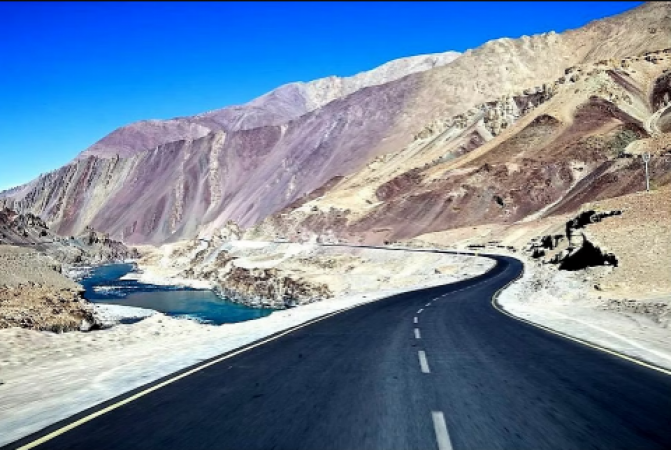
New Delhi: The winding high Himalayan route to Zemithang, a frontier village in India, is dotted with newly built roads, bridges, upgraded military camps, and new civilian infrastructure. China renamed Zemithang last month to bolster its claim to the region.
It is located in Arunachal Pradesh, a state in extreme northeastern India that Beijing claims to control almost entirely as "South Tibet."
The 3,500-kilometer (2,200-mile) divide between the two Asian superpowers—now known as the Line of Actual Control—was the subject of a war between them in 1962, and it is still a source of sporadic fighting and ongoing diplomatic wrangling.
Also Read: EAM Jaishankar holds talks with Chinese FM Qin Gang
Arunachal Pradesh, which is predominately Tibetan in culture, is a ferocious terrain for battle, with mountain passes as high as 4,750 metres (15,000 feet) that are still covered in snowdrifts in May and lower slopes that are heavily forested.
Both powers are currently engaged in significant construction campaigns to strengthen their positions.Zemithang was renamed "Bangqin" along with 10 other locations, which caused New Delhi to sneer at Beijing's announcement in April.
The state "is, has been, and will always be an integral and inalienable part of India," according to foreign ministry spokesman Arindam Bagchi. He continued, "Attempts to assign invented names will not alter this reality."
Beijing has previously attempted to use force to alter the truth.
Zemithang, a picturesque town just a few kilometres from the border The largest and oldest Tibetan Buddhist monastery outside of Lhasa is located in Tawang, the district's main town, which was also taken by Chinese forces in 1962 as they humiliated Indian troops before fleeing.
Brig. N.M. Bendigeri, who is in charge of thousands of soldiers in Tawang, is the Indian army officer tasked with avoiding a repeat of the incident. In December, hundreds of his men engaged in combat with Chinese forces.
And three years ago, at the westernmost point of the border in Ladakh, brutal hand-to-hand fighting resulted in the deaths of 20 Indian soldiers and four Chinese soldiers. The announcements from Beijing "won't change a thing here," according to Bendigeri. In actuality, however, Chinese actions are significantly altering the formerly unattended and remote region.
Prime Minister Narendra Modi's administration has invested billions of dollars in ambitious connectivity projects to increase civilian presence, create new paramilitary battalions, and counter China's build-up on the other side.
Also Read: Resuming registration for Syrian refugees who want to go home in Lebanon
With the addition of drones, cruise missiles, howitzers, and Chinook transport helicopters made in the US, India has strengthened its defences. India is a member of the Shanghai Cooperation Organisation, which also includes China and Russia, showing the ongoing geopolitical juggling act New Delhi engages in. It is hosting a gathering of its foreign ministers in Goa on Friday as the organization's current chair.
However, in response to China's increased assertiveness under leader Xi Jinping, it has also joined the US, Australia, and Japan in the so-called Quad, a group created to counter Beijing.
Amit Shah, India's powerful interior minister, introduced a $585 million "vibrant villages" programme for residents along the border just days after Beijing announced the renaming. In 1962, Shah declared in Kibithoo, one of the first villages in Arunachal Pradesh to be occupied, "India wants peace with everyone."
But nobody will be able to encroach on even a small portion of our nation's territory.
The push by its neighbour to create "xiaokang" — well-to-do villages in Mandarin — along the Line of Actual Control has alarmed New Delhi.
Bendigeri worries that they will be "dual-use ghost villages," designed to change the truths that exist in the real world.
In a similar vein to how Beijing has constructed militarised artificial islands in the contentious South China Sea, he is also concerned that the People's Liberation Army might use them during a conflict.
The Stockholm International Peace Research Institute estimates that India's military budget is only a little more than a quarter of China's, which limits its ability to respond.
And New Delhi cannot compel people to remain in the areas; it can only persuade them to do so. The state's 2,319 kilometres of roads and 35 infrastructure projects were approved by Modi's administration last year, according to reports. Tenzin Dorjey, a 35-year-old souvenir seller in Tawang, claims that more tourists are visiting his store, but the distance to the closest airport is still 12 hours.
Everything will be better for us and the visitors if the roads are improved, he claimed. The project's centrepiece is a tunnel that will run beneath the Sela pass and, according to Col. Ravikant Tiwari of the Border Roads Organisation, will be the longest tunnel in the entire world at a height of 4,000 metres.
He claimed that it would offer "all-weather connectivity" and "boost strategic defence infrastructure" in areas where winter snowstorms regularly cut the existing road. An army of workers toiled in the chilly weather. When the Dalai Lama fled into exile in 1959, he first arrived in India through Zemithang.
Also Read: India, Israel ink deal for Industrial Research, Development Cooperation
His crossing point is now a popular destination for pilgrims, who pass India's final army outpost and cross a flimsy old bridge over a raging river to pray at a "holy tree" he is said to have planted at the time.
On a slope about a kilometre away, a sizable Chinese military camp can be seen. According to local resident Sangey Tsetan, 61, "close ties with people from Tibet used to exist, but things changed after 1962." "We recall. We are not alike. They are Communists, while we are Buddhists.